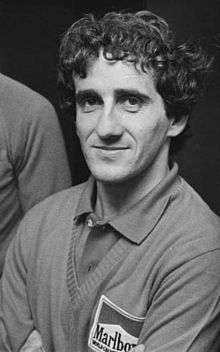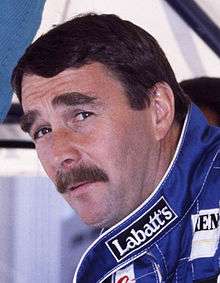1986 Formula One season
| 1986 FIA Formula One World Championship |
|||
| Drivers' Champion: Alain Prost Constructors' Champion: Williams-Honda | |||
| Previous: | 1985 | Next: | 1987 |


The 1986 Formula One season was the 37th season of FIA Formula One motor racing. It featured the 1986 Formula One World Championship which commenced on 23 March and ended on 26 October after sixteen races. The Formula One World Championship for Drivers was won by Alain Prost [1] and the Formula One World Championship for Manufacturers was awarded to Williams.[2] Prost became the first driver since Jack Brabham 26 years before to defend his championship title.
The championship culminated in a points battle between the Williams duo of Nelson Piquet and Nigel Mansell versus McLaren's Alain Prost at the final race, the 1986 Australian Grand Prix. Mansell's tyre blew in spectacular fashion and Piquet, in the lead at the time of the incident, was brought in for an unscheduled pit stop soon afterward by Williams to prevent the same happening to his tyres. This enabled Prost to take the lead and the race victory (his fourth of the season) and to secure his second consecutive Drivers' Championship.[3] Mansell, Piquet, Prost, along with Lotus' rising star Ayrton Senna, dominated throughout the season and formed what was popularly dubbed as the "Gang of Four".[4]
For the first time, turbocharged engines were compulsory due to a ban on naturally aspirated (atmospheric) engines. The law banning atmospheric engines was rescinded in 1987, in preparation for a ban on all forced induction engines for 1989. For 2014 turbocharged engines are now the norm effectively ending naturally aspirated (atmospheric) engines.
The Formula One cars of 1986 are the most powerful Grand Prix cars to ever have raced. There were still no limits on engine power, and some engines, including the powerful but rather unreliable BMW M12/13 1.5 litre single turbocharged straight-4 engine used by the Benetton, Brabham and Arrows teams, could throw out 1,350+ hp at 5.5 bar boost (79.7 psi) during qualifying; this would happen when the engineers took the boost restrictors off the engine – then the power of the turbocharged engines was so great that it could not even be accurately measured until years later, when the technology was advanced enough. Purpose-built drivetrains had to be fitted to the chassis of each car for specific sessions – there were qualifying engines (as described above) nicknamed "grenades" that had unrestricted boost pressure, and qualifying gearboxes, ones that were designed to withstand the engine's immense power; these components would only last about 3–4 minutes (2–3 laps) during use. These drivetrain units were then taken out and then replaced with the boost-restricted engines and specifically prepared gearboxes for races (if too much power was used, the engines would be so worn that the combusting in the engine would burst right through the block due to the immense stress on the metal caused by the extreme temperatures of the combustions in the engine's internals, hence the nickname "grenade"). When these turbocharged engines were fitted to the cars, the whole package weighed about 540 kg (1,190 lb) – so the power-to-weight ratios were extreme. For qualifying, the power to weight ratios were about 2,500 hp/ton+ for the Benetton-BMW and 1,850 hp/ton for the Benetton's race trim; compared to about 1,175 hp/ton for a modern F1 car – and all Formula 1 cars had manual stick-shift gearboxes then. To put that in perspective, a modern family car produces about 80–100 hp/ton and the fastest modern road-going cars produce about 450–550 hp/ton. But a consistent problem for these new turbo engines that was somewhat smoothed over (particularly by Ford and Honda) over the years was the terrible turbo lag; engines were mechanically turbocharged in those days. The power would only come on all at once 2–3 seconds after the driver put his foot down; it would usually measure out from 100–300 hp for the first 2–3 seconds then the engine would go immediately to the top of the power range (usually 900–1000 hp). The black and white nature of these engines made them very difficult to drive; drivers had to anticipate when the power would come on, so they would floor the gas pedal much earlier than usual to get the power on at the right moment.
The boost of the engines would often be restricted to the point where they would only be producing around 900–1,000 hp during the race. The major automotive manufacturers participating in F1 at the time, with their superior money and resources ran at the front of the turbocharged engine development race. The Honda twin-turbocharged V6 exclusively supplied to the Williams team were second to BMW in overall power and had slightly less power than the German engines, and the Ferrari, TAG/Porsche, and Renault twin-turbocharged V6 engines were not as powerful and as efficient as the Honda and BMW engines and produced about 25–40 less horsepower than the Japanese and German powerplants. The new Ford-Cosworth turbocharged V6 (a successor to the ubiquitous DFV V8) was made in a rush and was therefore underpowered and underdeveloped; it apparently had 150–200 less horsepower than the front-running European and Honda engines; but continued development meant that this engine got considerably better in 1987. And finally, the underfunded and very unreliable Alfa Romeo, Motori Moderni, Zakspeed and Hart engines were considerably less powerful than any of the others and kept their users down the order frequently. The power difference in engines from 1980 to 1986 was huge – the power of engines over those 6 years doubled. In 1980, the most powerful engine was the Renault twin-turbo V6 engine, which produced between 550–600 horsepower; most teams were using naturally-aspirated Ford-Cosworth DFV V8 engines in 1980 that produced about 480–510 hp.
At many races, particularly at high speed circuits such as Imola, Spa-Francorchamps, Hockenheim, the Österreichring and Monza, fuel consumption was always a concern, as the FIA lessened the amount of allowable fuel from 220 litres in 1984 and 1985 to 195 litres for 1986. As a result, fuel consumption became a problem for most teams since the engines were slightly more powerful than before. There were many races where a number of drivers ran out of fuel, most notably Alain Prost at Hockenheim, who very nearly finished third but ran out of fuel less than a quarter of a mile from the finishing line. He got out and desperately tried to push his stricken car across the finish line, ultimately never making it and finishing sixth. The Honda engines (second in power to the BMW engines) had the edge on fuel consumption and reliability, but the TAG/Porsche, Renault and BMW engineers were able to gain some ground later in the season.
Drivers who retired from F1 racing at the end of 1986 were Patrick Tambay, as well as 1980 World Champion Alan Jones and 1982 champion Keke Rosberg, while injuries suffered at the British Grand Prix forced the retirement of Jacques Laffite. Those who never drove in an F1 race again after 1986 were Johnny Dumfries, Huub Rothengatter and Allen Berg, while Marc Surer suffered a serious rally crash following his ninth-place finish in the Belgian Grand Prix which forced his retirement from driving altogether. Elio de Angelis was killed in a testing accident at the Circuit Paul Ricard after the Monaco Grand Prix; he remained the last driver to die in an F1 crash until Roland Ratzenberger at the 1994 San Marino Grand Prix.
The 1986 Formula One calendar featured two new events in the Hungarian Grand Prix, as well as the Mexican Grand Prix, the latter of which returned to the calendar after a sixteen-year absence. Two races exiting the calendar were the Dutch Grand Prix after 33 years, and the South African Grand Prix after 21 years.
Drivers and constructors
The following competitors contested the 1986 Formula One World Championship.
Results and standings
Grands Prix
The 1986 Formula One World Championship was contested over a sixteen race series.[2]
World Drivers' Championship final standings
Drivers' Championship points were awarded on a 9–6–4–3–2–1 basis to the top six finishers in each round.[5] However, only the best eleven round results were counted towards each driver's championship total.[6]
|
Bold – Pole position | ||||||||||||||||||||||||||||||||||||||||||||||||||||||||||||||||||||||||||||||||||||||||||||||||||||||||||||||||||||||||||||||||||||||||||||||||||||||||||||||||||||||||||||||||||||||||||||||||||||||||||||||||||||||||||||||||||||||||||||||||||||||||||||||||||||||||||||||||||||||||||||||||||||||||||||||||||||||||||||||||||||||||||||||||||||||||||||||||||||||||||||||||||||||||||||||||||||||||||||||||||||||||||||||||||||||||||||||||||||||||||||||||||||||||||||||||||||||||||||||||||||||||||||||||||||||||||||||||||||||||||||||||||||||||||||||||||||||||||||||||||||||||||||||||||||||||||||||||||||||||||||||||||||||||||||||||||||||||||||||||||||||||||||||||||||||||||||||||||||
† Drivers did not finish the Grand Prix, but were classified as they completed over 90% of the race distance.
() Results in parentheses were not counted towards the driver's championship total due to the limitation to the 11 best results.
World Manufacturers' Championship final standings
|
Bold – Pole position | ||||||||||||||||||||||||||||||||||||||||||||||||||||||||||||||||||||||||||||||||||||||||||||||||||||||||||||||||||||||||||||||||||||||||||||||||||||||||||||||||||||||||||||||||||||||||||||||||||||||||||||||||||||||||||||||||||||||||||||||||||||||||||||||||||||||||||||||||||||||||||||||||||||||||||||||||||||||||||||||||||||||||||||||||||||||||||||||||||||||||||||||||||||||||||||||||||||||||||||||||||||||||||||||||||||||||||||||||||||||||||||||||||||||||||||||||||||||||||||||||||||||||||||||||||||||||||||||||||||||||||||||||||||||||||||||||||||||||||||||||||||||||||||||||||||||||||||||||||||||||||||||||
† Drivers did not finish the Grand Prix, but were classified as they completed over 90% of the race distance.
Notes and references
- ↑ 1986 Formula One World Championship for Drivers (points table), 1987 FIA Yearbook, Red section, page 86
- 1 2 1986 Formula One World Championship for Manufacturers (points table), 1987 FIA Yearbook, Red section, page 87
- ↑ ESPN coverage of the 1997 Japanese Grand Prix, end-of-year F1 championship battles segment narrated by Bob Varsha
- ↑ "F1 season goes down to the wire". The Globe and Mail. 2010-11-08. Retrieved April 12, 2015.
- ↑ Peter Higham, The Guinness Guide To International Motor Racing, 1995, page 6
- ↑ Peter Higham, The Guinness Guide To International Motor Racing, 1995, page 120
- ↑ Only the best 11 results counted towards the Drivers' Championship. Numbers without parentheses are championship points; numbers in parentheses are total points scored.